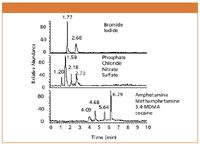An Accurate and Robust LC–MS Method for the Identification of Illicit Drug Salt Forms
Illicit cocaine, amphetamine, methamphetamine, and ecstasy (MDMA) are often encountered in the form of salts and identification of the specific counter ion present may provide valuable information about the source of production and the manufacturing pathway.
Guifeng Jiang, Terry Zhang, and Kathryn Preston, Thermo Fisher Scientific
Illicit cocaine, amphetamine, methamphetamine, and ecstasy (MDMA) are often encountered in the form of salts and identification of the specific counter ion present may provide valuable information about the source of production and the manufacturing pathway. Screening and identification of these stimulants in seized evidence requires an analytical method that is capable of detecting the salt forms.
LC–MS Analysis
The Thermo Scientific Accela LC system offers the flexibility of performing both conventional and high-speed LC separations on a single platform, and seamlessly integrates with the Thermo Scientific MSQ Plus Mass Detector, a sensitive and fast scanning single quadrupole mass spectrometer. The rapid polarity switching capability of the MSQ™ Plus Mass Detector enables simultaneous detection of cations and anions in a single analysis.
Results and Discussion
1. Separation and MS detection of drug and inorganic anion standards
Common salt forms of cocaine are chloride and bromide. Amphetamine is usually found in the chloride and sulfate forms. Bromide and chloride forms of methamphetamine are common, but iodide, phosphate, and nitrate forms may also be encountered. For 3,4-MDMA, bromide and chloride are the most common salt forms, although a phosphate form may occasionally be detected.
Separation of a mixture of cocaine, amphetamine, methamphetamine, and 3,4-MDMA standards as well as a mixture of six inorganic anions was achieved using a Hypercarb column and a single LC–MS method (Figure 1). Gradient elution was used to control selectivity and retention of the inorganic anions and the organic cations. The inorganic anions were separated within 3 min with an elution order of phosphate, chloride, bromide, nitrate, iodide, and sulfate. The drug standards were baseline-resolved in under 7 min and eluted in order of increasing hydrophobicity: amphetamine, methamphetamine, 3,4-MDMA, and cocaine.

Figure 1: Separation and detection of four drug standards and six inorganic anion standards.
The most abundant ions for the drug standards are the [M+H]+ ions, at m/z 136.12, 150.10,194.15, and 303.95 for amphetamine, methamphetamine, 3.4-MDMA, and cocaine, respectively.
2. Linearity and sensitivity
Excellent linearity in detector response was observed over the range of 0.125–2000 ng/mL for the drug standards and over the range of 1.14–29400 ng/mL for the inorganic ions, with correlation coefficients greater than 0.996 for all analytes.
Limits of detection (LODs) and limits of quantitation (LODs), are defined as S/N ratio of 3 and 10, respectively. For drug standards, LODs ranged from 0.3 to 0.5 ng/mL, and LOQs ranged from 1 to 2 ng/mL. For the inorganic ions, LODs were between 1.1 and 30 ng/mL, and LOQs ranged from 3.3 to 100 ng/mL.
3. Reproducibility
Reproducibility was investigated by analyzing three replicate injections of each analyte. Retention time RSDs ranged from 0.35– 0.92%, indicating excellent method reproducibility, particularly of the Accela UHPLC pump.
Conclusion
An accurate and robust LC–MS method for the identification of illicit drug salt forms was developed. Simultaneous separation and detection of cations and anions was achieved using a Hypercarb LC column and the polarity switching mode of the MSQ Plus MS. Furthermore, this method utilizes two uncorrelated parameters — retention time and mass spectral signature — to establish the identity of drug salt forms.

Thermo Fisher Scientific
2215 Grand Avenue Parkway, Austin, TX 78728
tel. (800) 532-4752; fax (561) 688-8731
Website: www.thermoscientific.com

Free Poster: NDSRI Risk Assessment and Trace-Level Analysis of N-Nitrosamines
April 25th 2025With increasing concern over genotoxic nitrosamine contaminants, regulatory bodies like the FDA and EMA have introduced strict guidelines following several high-profile drug recalls. This poster showcases a case study where LGC and Waters developed a UPLC/MS/MS method for quantifying trace levels of N-nitroso-sertraline in sertraline using Waters mass spectrometry and LGC reference standards.
New TRC Facility Accelerates Innovation and Delivery
April 25th 2025We’ve expanded our capabilities with a state-of-the-art, 200,000 sq ft TRC facility in Toronto, completed in 2024 and staffed by over 100 PhD- and MSc-level scientists. This investment enables the development of more innovative compounds, a broader catalogue and custom offering, and streamlined operations for faster delivery. • Our extensive range of over 100,000 high-quality research chemicals—including APIs, metabolites, and impurities in both native and stable isotope-labelled forms—provides essential tools for uncovering molecular disease mechanisms and exploring new opportunities for therapeutic intervention.
New Guide: Characterising Impurity Standards – What Defines “Good Enough?”
April 25th 2025Impurity reference standards (IRSs) are essential for accurately identifying and quantifying impurities in pharmaceutical development and manufacturing. Yet, with limited regulatory guidance on how much characterisation is truly required for different applications, selecting the right standard can be challenging. To help, LGC has developed a new interactive multimedia guide, packed with expert insights to support your decision-making and give you greater confidence when choosing the right IRS for your specific needs.
Using the Carcinogenic Potency Categorisation Approach (CPCA) to Classify N-nitrosamine Impurities
April 25th 2025Learn how to manage nitrosamine impurities in pharmaceuticals with our free infographic. Discover how the CPCA approach establishes acceptable intake limits and guides the selection of NDSRI reference samples. Stay compliant and ensure safety with our ISO-accredited standards.

.png&w=3840&q=75)

.png&w=3840&q=75)



.png&w=3840&q=75)



.png&w=3840&q=75)














